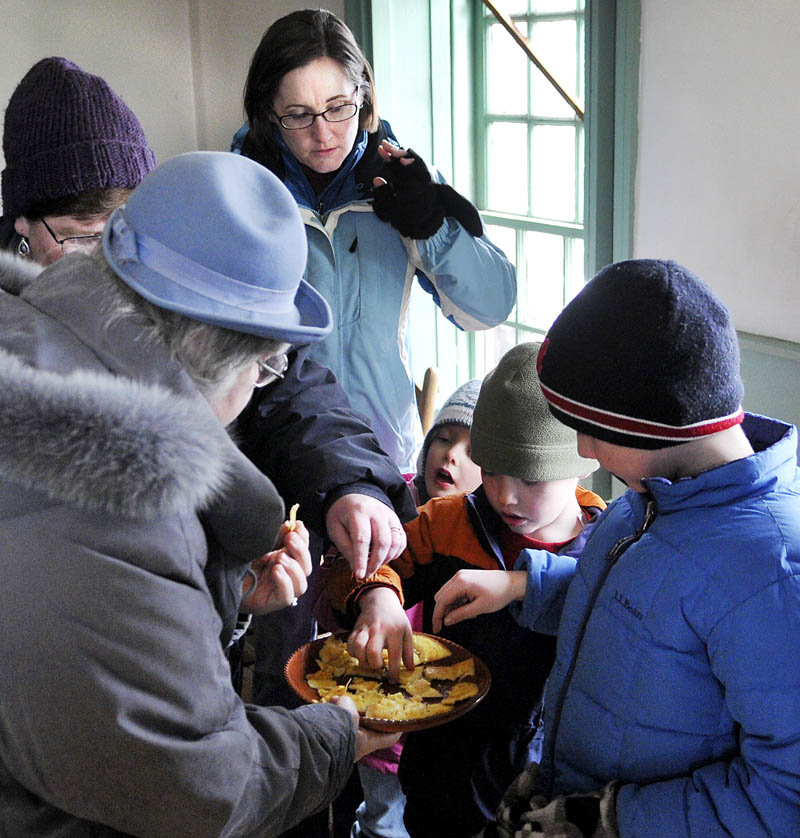AUGUSTA — They make maple syrup the old-fashioned way at Old Fort Western, boiling it slowly in an open kettle over an outdoor fire coaxing it to evaporate.
On Sunday, scores of people flooded the fort and nearby grounds to watch the process from tree to sugar and to inhale the heady smell of sticky-sweet steam.
Old Fort Western, the 1754 National Historic Landmark fort, store and house museum on the Kennebec River, hosted its 20th annual Maple Syrup Day on Sunday in connection with open houses at numerous other farms and sugar shacks throughout the state.
In a long blue greatcoat, Hannes Moll, of Windsor, guarded the fire that heated sap he had collected over the past month from 14 maple trees at his family’s farm.
Moll, 14, had filled a 30-gallon drum at home and evaporated enough sap to get several quarts of syrup for his family, keeping some for use at the fort.
“My granddad got me into it,” he said, crediting the late George Mayo.
Rebecca Manthey, of Benton, also wearing 18th-century garb, tended the sap, occasionally pouring more into the big black kettle.
“It takes 40 gallons of sap to make a gallon of maple syrup,” she explained to visitors who leaned over the pot to watch the process and asked how long it would take to become syrup.
“It depends on the fire, the weather, and how much more sap I pour into it,” she told them. It would be finished, she said, when the taste and color were right.
Nearby, another of the Old Fort Western staff members and volunteers showed how he would tap a tree so the sap poured would into a wooden collection trough on the ground.
Inside the stockade fence, Donna Parker, of Randolph, used a wooden spoon to stir a bowl of syrup that had been evaporated further and heated to show visitors how those living in the area hundreds of years ago used syrup to create sweetener.
Parker reminded visitors that the area’s former inhabitants would not have been able to refrigerate the syrup to preserve it, so they had to take other measures.
“It’s not for the flavor, it’s for the sweetener,” Parker emphasized, adding that while it required work to create, it was free. She said gathering the sap and evaporating it was a social event.
After hundreds of strokes by Parker and visitors, the syrup had the color of caramel and a consistency like taffy.
More stirring would give granules, and eventually it would become rock hard as all the moisture evaporated, Parker said. Then the resulting mass of maple sugar could be stored for use later in the year when the cooks would grate it or use a mortar and pestle to chip away at the brick of sugar.
“I remember buying blocks of maple sugar in 1957-58,” said visitor Jim Boutilier, 69, of Bremen, who sounded as though he’d like a taste again.
Parker gave him directions to a local farm that still sells those sugar blocks.
Other visitors, including 7-year-old Michael Joseph Harkins IV, of Litchfield, could hardly wait to reach the second floor of one of the blockhouses to get a close-up view of a small cannon visible in a window as other period demonstrations were under way.
More information about the fort is available online at oldfortwestern.org.
Betty Adams — 621-5631
badams@centralmaine.com
Send questions/comments to the editors.




Success. Please wait for the page to reload. If the page does not reload within 5 seconds, please refresh the page.
Enter your email and password to access comments.
Hi, to comment on stories you must . This profile is in addition to your subscription and website login.
Already have a commenting profile? .
Invalid username/password.
Please check your email to confirm and complete your registration.
Only subscribers are eligible to post comments. Please subscribe or login first for digital access. Here’s why.
Use the form below to reset your password. When you've submitted your account email, we will send an email with a reset code.